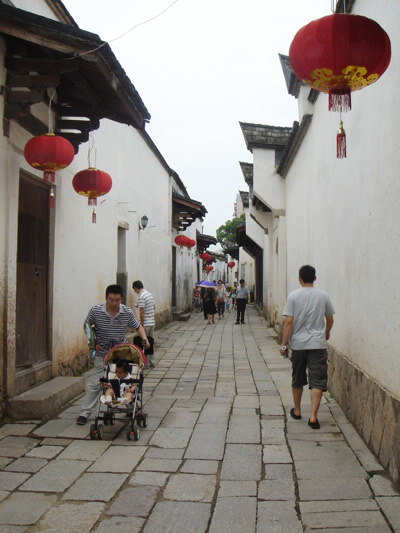|
 |
|
SLOW PACE: Visitors stroll down one of Sanfang Qixiang's alleys in Fuzhou, capital of Fujian Province, on May 19 (ELVIS ANBER) |
While most of China's provincial capitals offer little in the way for tourists, Fuzhou defies the norm and is quickly becoming a must visit destination along the country's already crowded eastern seaboard with its green focus and cultural heritage often overlooked by travelers.
Capital of Fujian Province, located in the southeast, Fuzhou's population is over 7 million, although it hardly feels congested. Traffic flows freely, and there's even a subway under construction, set to open in the next couple of years. Residents are some of China's richest, enjoying a per-capita income of close to $10,000 a year—and rising fast.
Much of Fuzhou and the province's wealth is due to its close ties with Taiwan, its more prosperous neighbor across the Straits, with plenty of capital and expertise from IT to animation invested in Fujian. Even the city streets resemble that of Taipei, with dozens of scooters—a popular mode of transport—zipping down a street at any given moment. Fuzhou, like other Chinese cities, is hoping to move up the value chain of goods produced by becoming a leading center for the outsourcing industry.
Fuzhou has managed to maintain an astonishing abundance of greenery. Well manicured trees, bushes and gardens are the norm and contribute a freshness to the air rarely seen in Chinese cities.
Air quality, a daily and growing concern in cities like Beijing and Lanzhou, is of no concern here. One 20-something woman I spoke to said she returned to Fuzhou to pursue a career after studying elsewhere in China simply because of the lack of air pollution. Indeed, the quality of its air has only improved with time and is ranked third among China's 31 provincial capitals and municipalities.
While plenty of greenery is intertwined in the city's concrete and steel, Fuzhou offers travelers a chance to escape to more natural surroundings. Downtown is home to the Wushan scenic area that offers a welcome respite from the city's often sweltering heat. Head up its winding, hilly maze of pathways to enjoy a light breeze and red engravings on several of the hill's rock formations. To the north behind Wushan is West Lake, modeled on the one in Hangzhou and a perfect spot for a stroll by the water.
It's no wonder Fuzhou has been given the titles of National Garden City and National Model Green City, to highlight its path toward sustainable development.
But the city's determination to remain green is matched by its need to preserve the remnants of its long history.
The center of Fuzhou is an historical delight. Sanfang Qixiang, or Three Lanes and Seven Alleys, is often described as a museum of Ming and Qing architecture, perhaps the largest of its kind in China. Sprouting out from the main road—where tea and souvenir shops and vendors selling cold drinks dominate—are white or wooden walled lanes and alleyways dating back over 700 years (some say the area's origins date back a few hundred years earlier).
There are 150 current residences, where well-known figures in the military, politics and the arts once called home. Expect to see a few main doors open for an inviting peek at some of the magnificent courtyards. Best of all, Three Lanes and Seven Alleys is a pedestrian area free of motorized vehicles. No doubt Sanfang Qixiang is Fuzhou's top tourist attraction.
For more Ming history, visit the Yushan Scenic Area nearby with its 1,100-year-old White Pagoda and Ming wall remains. And a mere 15 km east of the downtown core is the lush Gushan Mountain with its ancient Yongquan Temple.
While Xiamen and Quanzhou tend to crowd the itineraries of most travelers to Fujian Province, Fuzhou, a burgeoning city seeking to strike the right mix of development with natural and historical preservation, shouldn't be overlooked.
For one life-long resident in his 60s, the city's balanced development is welcomed. "There are more wider roads than before. But I don't mind."
The author is a Canadian living in Beijing | 